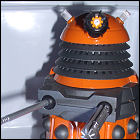 In 2010’s Victory Of The Daleks the Daleks appeared in their most radically updated form yet, reflecting Doctor Who showrunner Steven Moffat’s desire to make them bigger, more dangerous and more colorful (hearkening back to his memories of the Daleks in the two 1960s Peter Cushing Doctor Who movies). What no one seemed to anticipate was the public backlash against the new design: the Daleks, with a maniacal drive for homogeny written into their very genes, seemed somewhat unlikely to outfit themselves with bright, candy-colored casings. (It’s a little unfathomable why, outside of the necessities of TV, any Dalek would look different from any other Dalek: why put a bullseye on your seasoned leader’s back by making him the only Dalek in a shiny white casing?) A frequent comment after the debut of the new Daleks was the the change happened solely to make a new range of action figures possible. Whether or not that’s true, Character Options wasted little time in unleasing the new Dalek army on the toy-buying public.
In 2010’s Victory Of The Daleks the Daleks appeared in their most radically updated form yet, reflecting Doctor Who showrunner Steven Moffat’s desire to make them bigger, more dangerous and more colorful (hearkening back to his memories of the Daleks in the two 1960s Peter Cushing Doctor Who movies). What no one seemed to anticipate was the public backlash against the new design: the Daleks, with a maniacal drive for homogeny written into their very genes, seemed somewhat unlikely to outfit themselves with bright, candy-colored casings. (It’s a little unfathomable why, outside of the necessities of TV, any Dalek would look different from any other Dalek: why put a bullseye on your seasoned leader’s back by making him the only Dalek in a shiny white casing?) A frequent comment after the debut of the new Daleks was the the change happened solely to make a new range of action figures possible. Whether or not that’s true, Character Options wasted little time in unleasing the new Dalek army on the toy-buying public.
Victory Of The Daleks introduced us to five new “flavors” of Dalek, who each got a moment to introduce themselves by name on screen, like the founding members of the Skaro branch of the Mickey Mouse Club: the white Dalek Supreme, the blue Dalek Strategist, the orange Dalek Scientist, and the red Dalek Drone.
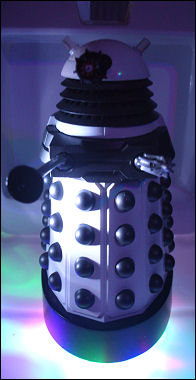

Dalek Supreme and Dalek Drone.
Last, there’s the enigmatically titled yellow Dalek Eternal, though even Steven Moffat himself has admitted that he came up with the name before doing any legwork to figure out the Dalek Eternal’s function. (In a few sixth Doctor Big Finish audios, there is a Dalek Time Controller who analyzes and predicts vulnerabilities in the timeline: either enemy vulnerabilities that can be exploited, or Dalek vulnerabilities that need to be eliminated so enemies don’t exploit them. Maybe this Dalek Time Controller has become the Dalek Eternal, with a fancy new mysterioso name.)
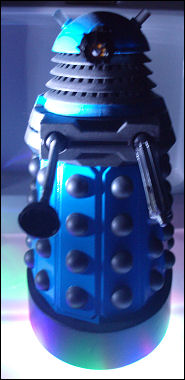
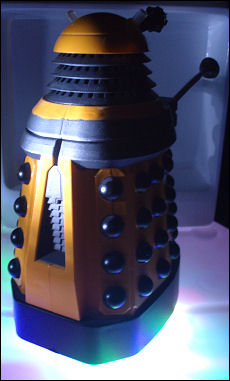
Dalek Strategist and Eternal: never has there been so much speculation about a Dalek’s function… or its backside. Plumber crack from Skaro?
The Dalek figures are pretty simple, but then that’s been the case all the way back to the first toy Daleks in the 1960s. Each Dalek is wheeled, and its gunstick and sucker arm are moveable, though the degree to which these limbs are moveable vary from figure to figure. The eye stalk of each Dalek appears to be articulated, now via a ball joint as with the other appendages instead of a hinge capable of pointing up or down, but none of the figures I have exhibit much range of movement with the eye; I finally stopped trying to avoid impairing any Dalek vision (they get dreadfully noisy when that happens).
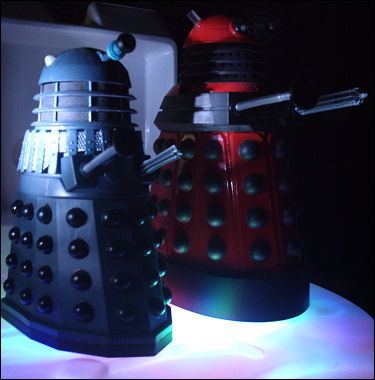
Dalek footsoldiers (minus feet), then (Genesis Of The Daleks, 1975) and now.
The new design is replicated faithfully, though whether or not that’s a good thing depends on whether you like the new design, or are simply a completist. The strange exhaust-port-like venting on the back is there too, though we still don’t know what it’s for. It’s interesting to note that only the Dalek Eternal’s pods (I hesitate to use the word “balls” here…) are jet black, while on every other Dalek these details are more of a matte charcoal. This is accurate to the Daleks seen in the show, and the significance of it remains a mystery right up there with the Dalek Eternal’s function.
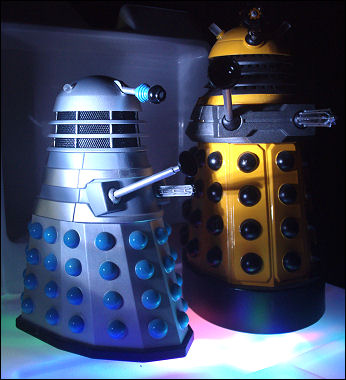
My, how you’ve grown: the first Dalek (>The Daleks, 1963) next to the latest new series Dalek. Be careful, he’ll put your eye out.
All five Daleks were issues in a New Dalek Paradigm wave with slightly altered packaging (the background image on the card showed the interior of the Dalek spacecraft from Victory, but was otherwise identical to other new series figure packaging in dimensions and other packaging elements), but originally they were harder to find; only the Dalek Drone and Dalek Strategist were widely available at first. The Dalek Eternal made its debut as an exclusive on both sides of the Atlantic: it was originally sold only as part of a six-figure boxed set available at Toys R Us in the U.K., while Stateside it was exclusive to the Hastings chain, whose cult-favorite-filled toy section has become the go-to American retail outlet for Character Options’ figures and  accessories. The Dalek Scientist was originally a 2010 Comic Con exclusive, packaged with an eleventh Doctor variant without his trademark tweed jacket; large quantities of this set came back to the warehouse from Comic Con and were subsequently directly sold online by Underground Toys, which seldom handles direct orders to individual consumers, usually operating through distribution channels. As of summer 2011, there are still many of these sets available, and in the U.S. they’ve finally begun to appear in Hastings stores and elsewhere; the New Dalek Paradigm wave packages the Scientist Dalek alone without the Doctor.
accessories. The Dalek Scientist was originally a 2010 Comic Con exclusive, packaged with an eleventh Doctor variant without his trademark tweed jacket; large quantities of this set came back to the warehouse from Comic Con and were subsequently directly sold online by Underground Toys, which seldom handles direct orders to individual consumers, usually operating through distribution channels. As of summer 2011, there are still many of these sets available, and in the U.S. they’ve finally begun to appear in Hastings stores and elsewhere; the New Dalek Paradigm wave packages the Scientist Dalek alone without the Doctor.
Now, about this new design: there’s probably some real-life, makes-it-easier-in-the-studio reason for the Daleks to suddenly be hunchbacked. I’m still getting used to the oversized eyes and much larger gun barrel. The smooth midsection is actually a throwback to the original Dalek design of the first two William Hartnell-era Dalek stories, but the vertical “slats” had become such a fixture of the Dalek design for so many years that it’s curious as to why they weren’t incorporated as a design feature somehow. Perhaps this is another makes-it-easier-in-the-studio thing. Ultimately, though, I’m not sure why the volume occupied by each Dalek had to be increased so dramatically. Part of the charm and the threat of the original Daleks, even the previous “tank” style new series Daleks, was that their height relative to a tall human being belied just how dangerous they were. Jon Pertwee and Tom Baker and every other Doctor down the line faced off against them and, Destiny Of The Daleks aside, took them seriously on screen, even if they towered over the casings. Like the Sontarans, the Daleks compensated for their height with sheer firepower, strength and single-mindedness. Underestimating a Dalek was a bit of a metaphor for the series from which they sprang: they might not appear to be up to much, but in the end they were quite formidable and seemed to be capable of rebounding from their total annihilation.
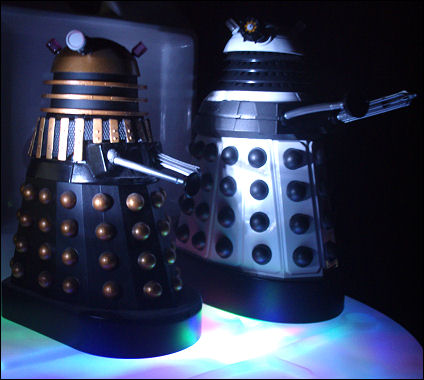
Ladies and gentlemen, the Supremes! The new Supreme Dalek has a height advantage on the tallest Supreme Dalek (Planet Of The Daleks, 1973) from the original series.
Sort of like a series that overcame 15 years off the air and returned as a mammoth hit.
Lighting inspired by Little E